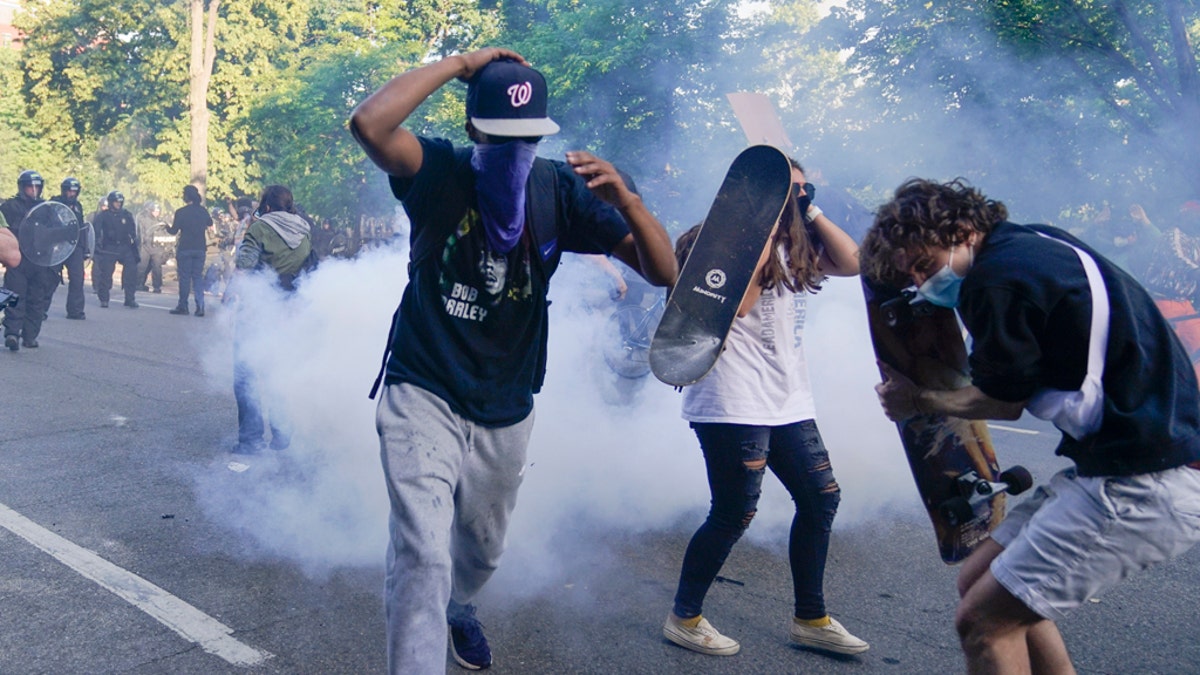Law enforcement officers use tear gas to clear protesters from downtown Atlanta
Police arrest more than 50 people in Atlanta; Jonathan Serrie reports.
Get all the latest news on coronavirus and more delivered daily to your inbox. Sign up here.
Law enforcement agencies nationwide have repeatedly used tear gas in attempts to restore order over crowds of protesters deemed hostile amid the unrest following the death of George Floyd, who died in custody of the Minneapolis police.
Whether the method is justified or not, the projectile has potential to inflict dangerous health consequences on those in harm’s way, experts say.

A protester is assisted with a solution to help neutralize the effects of tear gas fired by police outside the Minneapolis 5th Police Precinct, Saturday, May 30, 2020, in Minneapolis. Protests continued following the death of George Floyd, who died after being restrained by Minneapolis police officers on Memorial Day. (AP Photo/John Minchillo)
"Tear gas' intention is to cause immediate discomfort to a human," Dr. Panagis Galiatsatos, pulmonary and critical care physician and assistant professor of medicine at Johns Hopkins University, wrote in an email to Fox News. "The content and size of the aerosol are designed to immediately impact the eyes and respiratory system (from nose to lungs)."
For many people, it will cause temporary difficulty in breathing, Galiatsatos explained.
Alexander Isakov, executive director of the Office of Critical Event Preparedness and Response and professor of emergency medicine at Emory University School of Medicine, detailed the effects of chemical irritants in tear gas in an email to Fox News.
“They are generally expected to cause a burning sensation and tearing from the eyes, spasm of the eyelids, a burning sensation and running of the nose, sneezing, coughing and superficial skin discomfort," Isakov wrote.
Though Isakov said the use of tear gas is “generally considered safe," he did note the risk of more serious injury depending on how the agent is delivered. People can get hurt if they’re struck by the projectile canister, or if the skin is exposed to any heat produced by the delivery device.

Demonstrators, who had gathered to protest the death of George Floyd, begin to run from tear gas used by police to clear the street near the White House in Washington, Monday, June 1, 2020. (AP Photo/Evan Vucci)
People with underlying medical conditions can be more seriously affected by the chemical irritant, if, for instance, the irritant triggers an asthma attack, Isakov wrote.
If tear gas is used on people in an enclosed setting, where they cannot escape, the risk of injury increases due to overexposure, Isakov wrote.
SOCIAL DISTANCING, FACE MASKS CURB CORONAVIRUS RISK, FINDS LARGEST REVIEW OF STUDIES TO DATE
Dr. Russell Buhr, assistant professor of medicine in the division of pulmonary and critical care at the David Geffen School of Medicine at UCLA, told Fox News, without proper attention, an asthma attack brought on by irritants in tear gas could be lethal.
Buhr also detailed how tear gas and pepper spray have “demonstrated health risks.”

Tear gas billows as demonstrators gather in Lafayette Park to protest the death of George Floyd, Sunday, May 31, 2020, near the White House in Washington. (AP Photo/Alex Brandon)
Buhr cited a 2017 BMC Public Health systematic review of 31 other studies, which found over 9,000 documented injuries, including two deaths and 58 people who suffered permanent disability from tear gas and pepper spray when used in crowd control.
Buhr also noted how injuries from the projectiles that deploy the gases can include “blunt force trauma and burns that can result in permanent loss of vision.”
According to Galiatsatos, if the trauma is executed at a person's head, there's the risk of suffering a concussion. Trauma toward the chest may result in difficulty breathing, or chest pain.
"Some blunt force trauma could even result in death, though the risk there is low," Galiatsatos wrote. Meanwhile, he also explained whether the chemicals in tear gas can cause vision loss.
"Vision loss depends on the chemicals used, but for the most part, vision loss should not be an immediate complication, or if it is, it would be transient," Galiatsatos wrote. "These chemicals are not intended to lead to permanent issues, but more immediate discomfort. However, being hit in the eye by the canisters could result in corneal scarring that could lead to temporary or permanent vision loss."
Buhr says, from a public health point of view, the use of the agents should be “extremely rare.” He also says demonstrators should be given plenty of warning before the deployment of agents to allow those who are most vulnerable to injury to get out of harm’s way.
CORONAVIRUS CAUSES SHORTAGE OF POPULAR ANTIDEPRESSANT
Buhr advises demonstrators to wear eye protection to protests, as well as face coverings to minimize the spread of coronavirus.
“Anyone seeking to demonstrate should consider bringing any emergency medications like asthma inhalers, as well as a piece of paper with a list of medical conditions, allergies, and prescribed medications so that in the event they are injured or sick, doctors and nurses can provide them the best care possible,” Buhr wrote.

